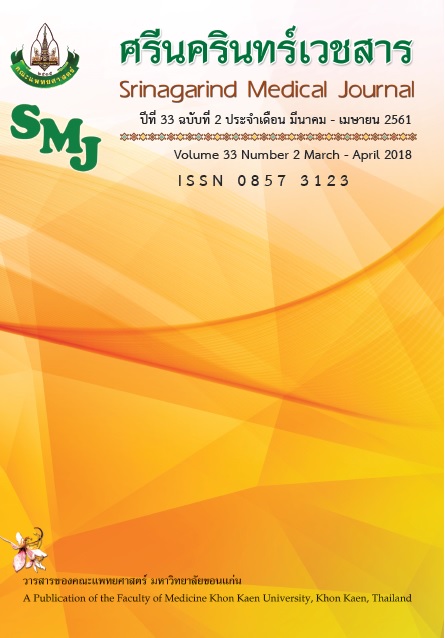Role of Neurovascular System of the Mesenteric Arterial Wall in the Control of Peripheral Vascular Resistance
Keywords:
mesenteric artery; perivascular nerve; peripheral vascular resistance; หลอดเลือดแดงมีเซนเทอริก; ใยประสาทบนผนังหลอดเลือด; ความต้านทานรวมของหลอดเลือดส่วนปลายAbstract
Abstract
Relaxation and constriction of resistance arteries are the important mechanisms for maintaining normal blood pressure. Functions of perivascular nerves that innervate vascular walls enable prompt alteration of total peripheral resistance. Rat mesenteric arteries have been used as a model for the study of the pathophysiological and pharmacological aspects of roles of nervous system in the function of resistance arteries. Mesenteric arteries are innervated by several types of nerve fibers including adrenergic, CGRPergic, nitrergic, and cholinergic nerves. The ability of each type of nerve in controlling vascular function depends on the type of neurotransmitter as well as nerve fiber density. Neurotransmitters may be released and act directly on vascular smooth muscle cells or indirectly by modulating presynaptic function on axons of the same or different types of nerve fibers. Dysfunction of certain types of nerve fibers may be related to abnormal blood pressure. Therefore, understanding the nature of these nerve fibers would be helpful in the development of antihypertensive medication which specifically acts on perivascular nerves of resistance arteries.
บทบาทของระบบประสาทบนผนังหลอดเลือดแดงมีเซนเทอริกในการควบคุมความต้านทานรวมของหลอดเลือดส่วนปลาย
ดิเรก เอกธรรมรัฐ, ปณต ตั้งสุจริต, พัชรีวัลย์ ปั้นเหน่งเพ็ชร
ภาควิชาเภสัชวิทยา คณะแพทยศาสตร์ มหาวิทยาลัยขอนแก่น ขอนแก่น
บทคัดย่อ
การหดและคลายตัวของหลอดเลือดต้านทานเป็นกลไกสำคัญหนึ่งที่ร่างกายใช้ควบคุมความดันเลือดให้เป็นปกติ การทำงานของระบบประสาทบนผนังหลอดเลือดช่วยให้ร่างกายสามารถปรับเปลี่ยนความต้านทานรวมของหลอดเลือดส่วนปลายได้อย่างรวดเร็ว หลอดเลือดแดงขนาดเล็กมีเซนเทอริกของหนูแรทถูกใช้เป็นแบบจำลองเพื่อศึกษาบทบาทของระบบประสาทต่อการทำงานของหลอดเลือดต้านทานทั้งในเชิงพยาธิสรีรวิทยาและเภสัชวิทยา บนผนังหลอดเลือดชนิดนี้สามารถพบใยประสาทหลายชนิด ได้แก่ใยประสาทอะดรีเนอร์จิก ซีจีอาร์พีเออร์จิก ไนเตรอร์จิก และโคลิเนอร์จิก ศักยภาพในการควบคุมหลอดเลือดของใยประสาทแต่ละชนิดมีความแตกต่างกันไปขึ้นอยู่กับชนิดของสารสื่อประสาทและความหนาแน่นของใยประสาทชนิดนั้นๆ สารสื่อประสาทอาจถูกปล่อยและเข้าไปมีผลโดยตรงต่อกล้ามเนื้อเรียบหลอดเลือด หรืออาจมีผลโดยอ้อมด้วยการเข้าไปปรับเปลี่ยนการทำงานบริเวณก่อนซิแนปส์ของใยประสาทชนิดเดียวกันหรือต่างชนิดกันซึ่งอาจเป็นการกระตุ้นหรือยับยั้งการทำงานก็ได้ ความบกพร่องของใยประสาทบางชนิดสัมพันธ์กับความผิดปกติของความดันเลือด ดังนั้น ความเข้าใจเกี่ยวกับใยประสาทเหล่านี้น่าจะเป็นประโยชน์ต่อการพัฒนายาควบคุมความดันเลือดที่ออกฤทธิ์จำเพาะต่อระบบประสาทบนผนังหลอดเลือดต้านทาน




